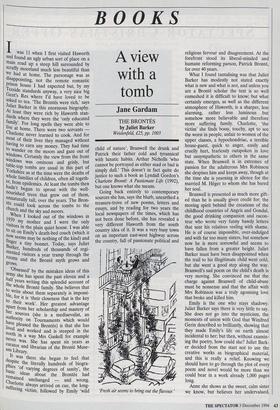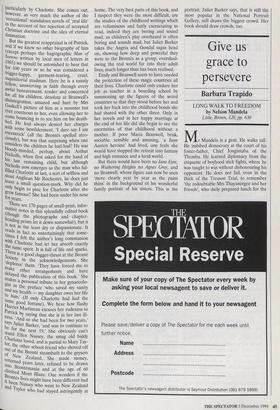BOOKS
A view with a tomb
Jane Gardam
THE BRONTES by Juliet Barker Weidenfeld, £25, pp. 1003 Iwas 11 when I first visited Haworth and found an ugly urban sort of place on a main road up a steep hill surrounded by Scruffy moorland much less beautiful than we had at home. The parsonage was as disappointing, not the remote romantic Prison house I had expected but, by my Teeside standards anyway, a very nice big Gent's Res where I'd have loved to be asked to tea. 'The Brontes were rich, says Juliet Barker in this enormous biography. At least they were rich by Haworth stan- dards where they were the 'only educated family'. For long spells they were able to live at home. There were two servants — Charlotte never learned to cook. And for most of their lives they managed without having to earn any money. They had time to wander on the moors and gaze out of windows. Certainly the view from the front windows was ominous and grisly, but table-top tombs are usual in this part of Yorkshire as at the time were the deaths of Whole families of children, often all togeth- er, from epidemics. At least the tombs then hadn't begun to sprout with the well- nourished trees that grew out of them, unnaturally tall, over the years. The Bron- tes could look across the tombs to the church and the sky and moors. When I looked out of the windows in 1939 my mother and I were the only visitors in the plain quiet house. I was able to sit on Emily's death-bed couch (which it now seems may be nothing of the kind) and finger a tiny bonnet. Today, says Juliet Barker, hundreds of thousands of regi- mented visitors a year tramp through the rooms and the Bronte myth grows and grows.
'Obsessed' by the mistaken ideas of this army she has spent the past eleven and a half years writing this splendid account of the whole Bronte family. She believes that to write about them separately is impossi- ble, for it is 'their closeness that is the key to their work'. Her greatest advantage apart from her scholarship and mastery of her sources (she is a mediaevalist, an authority on Tournaments which would have pleased the Brontës) is that she has lived and worked and is steeped in the north in a way Mrs Gaskell for example never was. She has spent six years as curator and librarian of the Brontë Muse- um Library. ItWas there she began to feel that despite the literally hundreds of biogra- phies 'of varying degrees of sanity', the basic ideas about the Brontës had remained unchanged — and wrong. Charlotte always arrived on cue, the long- suffering victim, followed by Emily 'wild child of nature', Branwell the drunk and Patrick their father cold and tyrannical with lunatic habits. Arthur Nicholls 'who cannot be portrayed as either mad or bad is simply dull.' This doesn't in fact quite do justice to such a book as Lyndall Gordon's Charlotte Bronte: A Passionate Life (1992), but one knows what she means.
Going back entirely to contemporary sources she has, says the blurb, unearthed a treasure-trove of new poems, letters and essays, and by reading for two years the local newspapers of the times, which has not been done before, she has revealed a very different Haworth from the south country idea of it. It was a very busy town on an important east-west highway across the country, full of passionate political and 'Fresh air seems to bring out the flavour.' religious fervour and disagreement. At the forefront stood its liberal-minded and humane reforming parson, Patrick Brontë, for over 40 years.
What I found tantalising was that Juliet Barker has modestly not stated exactly what is new and what is not, and unless you are a Brontë scholar the text is so well enmeshed it is difficult to know; but what certainly emerges, as well as the different atmosphere of Haworth, is a sharper, less alarming, rather less luminous but somehow more believable and therefore more suffering family. Charlotte, 'the victim' she finds bossy, touchy, apt to see the worst in people, unfair to women of the upper classes, a hypochondriac, a terrible house-guest, quick to anger, easily and cruelly hurt, fearlessly outspoken in love but unsympathetic to others in the same state. When Branwell is in extremes of passion for the adulterous Mrs Robinson she despises him and keeps away, though at the time she is yearning in silence for the married M. Heger to whom she has bared her soul.
Branwell is presented as much more gift- ed than he is usually given credit for; the moving spirit behind the creations of the childhood countries of Angris and Gondal, the good drinking companion and racon- teur who wrote very funny bawdy letters that sent his relatives reeling with shame. He is of course impossible, over-indulged and with far too many sisters, but somehow now he is more sorrowful and seems to have fallen from a greater height. Juliet Barker must have been disappointed when the trail to his illegitimate child went cold, but she went a good step along the way. Branwell's sad poem on the child's death is very moving. She convinced me that the charge against Branwell of child-abuse must be nonsense and that the affair with Mrs Robinson was a truly agonising love that broke and killed him.
Emily is the one who stays shadowy. Juliet Barker says there is very little to say. She does not go into the mysticism, the moments of union with God that Winifred Gerin described so brilliantly, showing that they made Emily's life on earth almost incidental to her; but then, without examin- ing the poetry, how could she? Juliet Bark- er decided from the start not to use the creative works as biographical material, and this is really a relief. Knowing we should have to go through the plot of every poem and novel would be more than we could bear in a work already 1,000 pages long.
Anne she shows as the sweet, calm sister we know, but believes her undervalued, particularly by Charlotte. She comes out, however, as very much the author of the 'sensational' scandalous novels of 'real life' in the account of her rejection of accepted Christian doctrine and the idea of eternal damnation.
But the greatest reappraisal is of Patrick, and if we knew no other biography of him (except perhaps the hagiographic Man of Sorrow written by local men of letters in 1965) we should be astonished to hear that for 100 years or so he was considered a trigger-happy, garment-tearing, cruel, inquisitorial madman. Here he is a saintly fellow, unswerving in faith through every awful bereavement, tender and concerned for all his children, desolate at Branwell's disintegration, amazed and hurt by Mrs Gaskell's picture of him as a monster but ever courteous to her, even allowing her to Come bouncing in to see him on his death- bed. He had always denied her charges With some bewilderment. 'I dare say I am excentrick (all the Brontës spelled atro- ciously), but was that surprising when one considers the children he had had? He was bloody-minded, perhap, about Arthur Nicholls, when first asked for the hand of his last remaining child, but although N. icholls now emerges as the man who ful- filled Charlotte at last, a sort of selfless and stout Anglican Mr Rochester, he does just leave a small question-mark. Why did he °My begin to pine for Charlotte after she grew famous? She had been under his nose for years.
There are 170 pages of small-print, infor- mative notes in this splendidly edited book (though the photographs and chapter- heading prints let it down somewhat), but it Is not in the least dry or dispassionate. It r.eads in fact so entertainingly that some- times I felt the author's long communion with Charlotte had let her absorb exactly the same spirit. It is full of life and sparks: There is a good dagger-thrust at the Brontë elcierY in the acknowledgements. She deplores' them. 'They have forced me to make other arrangements and have delayed the publication of this book.' She makes a personal tribute to her gynaecolo- gist in the preface 'who saved my sanity and my health — my daughter owes her life to him.' (If only Charlotte had had the same. good fortune). We hear how flashy Harnet Martineau excuses her rudeness to Patrick by saying that she is in her last ill- ness. `And so she had been for two years,' says Juliet Barker, `and was to continue to be for the next 19.' She obviously can't and Ellen Nussey, the smug old biddy jCharlotte loved, and is partial to Mary Tay- or, the other school-friend who shoved off Out of the Bronte steambath to the geysers of New Zealand. She made money, returned years later, refused to be drawn al.to Brontemania and at the age of 60 cjimbed Mont Blanc. One wonders if the rontds lives might have been different had it be - en Nussey who went to New Zealand and Taylor who had stayed astringently at home. The very best parts of this book, and I suspect they were the most difficult, are the studies of the childhood writings which are voluminous and fairly excruciating to read, indeed they are boring and sound mad, as children's play overheard is often boring and sounds mad; but Juliet Barker takes the Angria and Gondal sagas head on, showing how deep and powerful they were to the Brontës as a group, overshad- owing the real world far into their adult lives, much longer than has been realised.
Emily and Branwell seem to have needed the protection of these magic countries all their lives. Charlotte could only endure her job as teacher in a boarding school by summoning up the figures of the weird countries so that they stood before her and took her back into the childhood bonds she had shared with the other three. Only in her novels and in her happy marriage at the end of her life did she begin to see the enormities of that childhood without a mother. If poor Maria Branwell, brisk sociable, sensible and amusing, 'a Jane Austen heroine' had lived, one feels she would have stopped the retreat into fantasy and high romance and a lurid world.
But there would have been no Jane Eyre, no Wuthering Heights no Agnes Grey, and no Branwell, whose figure can now be seen 'more clearly year by year as the paint thins' in the background of his wonderful family portrait of his sisters. This is the portrait, Juliet Barker says, that is still the most popular in the National Portrait Gallery, still draws the biggest crowd. Her book should draw crowds, too.











































































 Previous page
Previous page